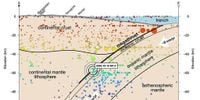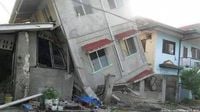On October 10, 2025, the southern Philippines was rocked by a pair of powerful earthquakes that left a trail of destruction, fear, and uncertainty across Mindanao and surrounding islands. The day began with a magnitude 7.4 quake striking offshore, about 43 kilometers east of Manay town in Davao Oriental province, at a depth of 23 kilometers along the Philippine Trench. According to the Philippine Institute of Volcanology and Seismology (PHIVOLCS), this was one of the strongest earthquakes to hit the area in recent memory, and its effects were felt far and wide.
The initial earthquake, which struck at 9:44 AM local time, sent shockwaves through the region, causing buildings to sway, power lines to whip violently, and residents to flee into the streets. The shaking reached intensity VI (strong) according to PHIVOLCS, and the U.S. Geological Survey (USGS) reported even higher readings, with some areas experiencing intensity VIII (severe) shaking. The quake lasted several minutes, with one resident in Santo Niño, approximately 110 kilometers from the epicenter, recalling, “Electricity and water went out. It lasted for a few minutes. But it felt like it was longer. It started intensely and then got even worse. We ran for our lives. My mom stumbled on the ground. It was so scary.”
The human toll was immediate and tragic. As reported by the Associated Press, at least five people lost their lives in the aftermath of the first quake. Among the victims were two hospital patients who died of heart attacks during the chaos and a resident in Mati city who was fatally struck by debris. In Pantukan town, Davao de Oro province, a landslide triggered by the tremor claimed the lives of two villagers and left several others injured. Army troops and civilian volunteers worked together to rescue survivors from the remote gold-mining village, highlighting the community’s resilience even in the face of disaster.
Buildings throughout the region suffered significant damage. Several structures developed cracks, including a high school in Governor Generoso town, where about 50 students had to be transported to a hospital for treatment of bruises, fainting, and dizziness. The international airport in Davao city, the largest metropolis near the epicenter with a population of about 5.4 million, also sustained cracks but remained operational, with no flights canceled, according to Office of Civil Defense deputy administrator Bernardo Rafaelito Alejandro IV.
The intensity of the shaking forced authorities to suspend school classes at all levels in Davao Oriental and Davao city. Children evacuated their classrooms, and parents rushed to collect them, adding to the day’s anxiety. Jun Saavedra, a disaster mitigation officer from Governor Generoso, described the terrifying experience to the Associated Press: “I was driving my car when it suddenly swayed and I saw power lines swaying wildly. People darted out of houses and buildings as the ground shook and electricity came off. We've had earthquakes in the past, but this was the strongest.”
Adding to the sense of urgency, a tsunami alert was issued for six coastal provinces near Davao Oriental. The Pacific Tsunami Warning Center in Honolulu reported that small waves were detected on the coasts of the Philippines and Indonesia, with wave heights in North Sulawesi, Indonesia, ranging from 3.5 to 17 centimeters. Fortunately, the threat passed within two hours, and the warning was lifted without any major waves impacting the coastline. Still, the brief evacuation of coastal areas underscored the ever-present risk of tsunamis following large offshore earthquakes in this seismically active region.
As if one powerful earthquake wasn’t enough, the same southern region was jolted again later that night. A second offshore quake, this time with a preliminary magnitude of 6.9, struck near Manay town at a depth of 10 kilometers. PHIVOLCS chief Teresito Bacolcol explained that this event was caused by movement along the same fault line—the Philippine Trench—as the morning’s quake. It remained unclear whether the second tremor was a distinct earthquake or a particularly strong aftershock, but it certainly added to the anxiety and confusion of residents already reeling from the day’s events.
President Ferdinand Marcos Jr. addressed the nation, stating that the government was assessing the extent of the damage and preparing rescue teams and relief operations. He assured the public that these resources would be deployed as soon as it was safe to do so, reflecting the country’s ongoing struggle to respond to frequent natural disasters. The Philippines, after all, is no stranger to such challenges: just ten days earlier, on September 30, 2025, a magnitude 6.9 earthquake near Cebu island had killed at least 74 people and displaced thousands. The archipelago is battered by about 20 typhoons and storms each year, making disaster preparedness a constant concern for both government agencies and volunteer groups.
The scientific community has closely monitored the seismic sequence. According to Earthquake Insights, the October 10 mainshock was followed by numerous aftershocks, including a magnitude 6.7 event about ten and a half hours later. These aftershocks tended to occur south and southeast of the main event, suggesting a rupture direction along the fault. The region’s tectonic setting is complex and hazardous: the Philippine subduction zone, also known as the Philippine Trench, marks the collision of the Philippine Sea Plate with the Sunda Plate. This fast-moving subduction zone—where plates converge at about 8–10 centimeters per year—produces frequent and sometimes devastating earthquakes, many of which are shallow and capable of causing widespread damage and tsunamis.
Earthquake Insights also noted that the October 10 event occurred on the same fault as a magnitude 7.6 quake east of Mindanao on December 2, 2023, though separated by about 100 kilometers. While stress changes from the 2023 earthquake may have slightly increased the hazard at the 2025 location, scientists caution that it’s impossible to say whether one event directly triggered the other. In regions as seismically active as the Philippines, large earthquakes can appear to cluster in time simply by chance.
For residents of Mindanao and the eastern Philippines, the events of October 10, 2025, were a stark reminder of their vulnerability to nature’s most unpredictable forces. As the government and communities mobilize to recover, the scars—both physical and psychological—will likely linger long after the aftershocks subside. But amid the devastation, the resilience and solidarity of the Filipino people shine through, as they have so many times before in this earthquake-prone land.






